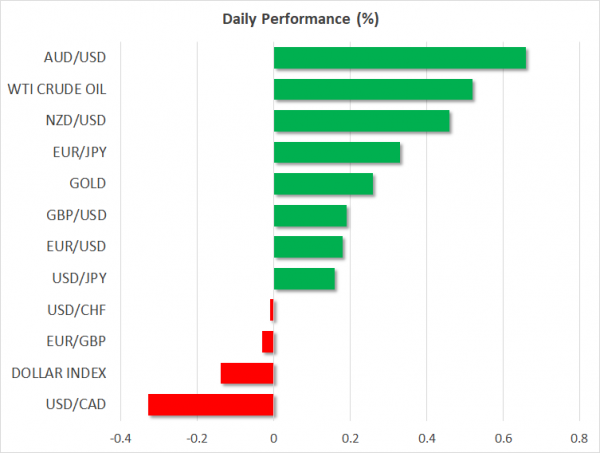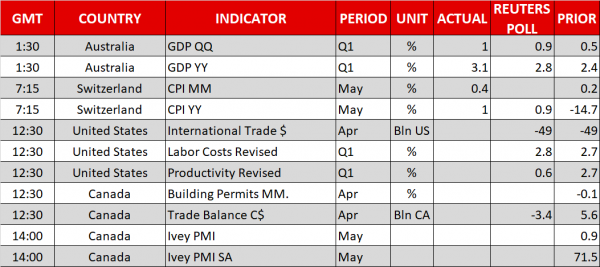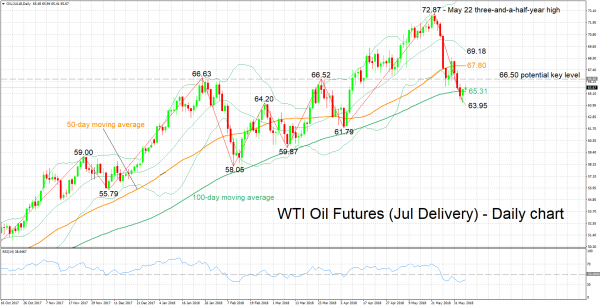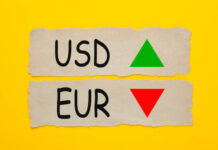Here are the latest developments in global markets:
FOREX: The US dollar index is trading 0.1% lower on Wednesday, looking set to post its third consecutive day of declines. The euro continued to recover amid speculation around an ECB QE announcement coming sooner rather than later, while the Canadian dollar went for a ride following mixed signals on NAFTA.
STOCKS: Major US indices closed mixed yesterday, with the tech-heavy Nasdaq Composite and the S&P 500 climbing by 0.41% and 0.07% respectively, but the Dow Jones edging lower by 0.06%. Risk sentiment looks to have improved notably though, with futures tracking the Dow, S&P, and Nasdaq 100 all currently flashing green, pointing to a higher open today. In Asia, Japan’s Nikkei 225 and the Topix rose by 0.38% and 0.15% correspondingly, while in Hong Kong, the Hang Seng was up by 0.66%. In Europe, futures tracking all the major indices were a sea of green, suggesting these benchmarks may open with gaps to the upside today.
COMMODITIES: Oil prices rose on Wednesday, building on some gains from yesterday. WTI is up by 0.5% while Brent is trading 0.8% higher, buoyed by fresh Reuters reports suggesting that Venezuela’s main oil producing company may soon be unable to service prior contracts it had with buyers. The report seemed to overshadow other news that the US may formally ask Saudi Arabia and other major producers to raise their output to offset supply outages from Iran and elsewhere. In precious metals, gold is up by almost 0.3% today, currently trading a couple of dollars below the $1,300/ounce level. The yellow metal continues to trade in a very narrow range after having been rejected from its 200-day moving average multiple times recently, which keeps the technical picture cautiously negative.
Major movers: ECB speculation lifts the euro; loonie & peso hit by NAFTA uncertainties
The common European currency got a helpful hand yesterday from a Bloomberg report which suggested the ECB could announce an end-date to its QE program as soon as at next week’s policy meeting, citing sources familiar with the matter. This probably came as a surprise for most investors, considering that the streak of soft economic data and the Eurozone’s recent political woes were widely expected to keep the ECB sidelined at least until July before making a decision on QE. Euro/dollar surged to break back above 1.1700 on the news, and is also trading 0.2% higher today.
While the euro could perhaps continue to recover in the coming days as markets digest these signals and price in a potential QE-announcement by next week, one must sound a note of caution, as an actual decision still seems unlikely to be taken so early. At its latest gathering, the Bank signaled it will maintain a cautious approach while it monitors whether the recent bout of economic weakness was transitory or more persistent. If anything, data since then have continued to paint a picture of a slowing economy, so the ECB has little motivation to take the next step towards the QE-exit door, for the moment.
Elsewhere, pound/dollar is 0.2% higher today, extending its gains from yesterday after the UK services PMI for May rose by more than expected, reigniting hopes that the economy’s recent soft patch may have indeed been transitory, as the BoE believes. That said, markets remain hesitant to price in a greater likelihood for a rate hike as soon as August, with the probability for such action remaining stuck around 45% according to the UK OIS.
On the trade front, the Canadian dollar and the Mexican peso stumbled on Tuesday, after White House economic advisor Larry Kudlow suggested the US is considering holding separate negotiations with Canada and Mexico. Dollar/loonie touched a fresh two-month high of 1.3065, before it retreated to erase all its gains a few hours later as the US dollar lost some ground, and following a report that Treasury Secretary Mnuchin urged Trump to exempt Canada from the recent metal tariffs.
In the antipodeans, aussie/dollar rose by 0.65% today, briefly touching a six-week high of 0.7610 after Australia’s GDP data for Q1 beat expectations. Kiwi/dollar is nearly 0.5% higher as well.
Day ahead: Trade data and related developments closely watched
Wednesday is going to be a relatively quiet day in terms of data releases, though some trade data out of the US and Canada are likely to attract attention, especially in light of trade frictions and a G7 summit commencing on Friday in Quebec, where trade is likely to rank high on the agenda.
At 1230 GMT, trade figures will be made public out of the US, with the trade deficit expected to have remained at $49 billion in April, after a sharp decrease in March attributed to record high exports. The politically-sensitive bilateral deficit with China will also be attracting attention. In the big picture, these numbers do not constitute a typical market mover in FX markets, though the latest developments on the trade front are rendering them of more interest. First-quarter data on labor costs and productivity will also be released out of the world’s largest economy at the same time.
Again at 1230 GMT, Canada will be on the receiving end of trade numbers for April as well; the nation’s trade deficit is projected to shrink to C$3.4bn from March’s deficit of around C$4.1bn. Canadian building permits are slated for release at the same time, while later in the day (1400 GMT), May’s Ivey PMI is also due out of the country.
The Canadian dollar and Mexican peso took a hit yesterday on the back of worries that the US will pull out of NAFTA. In this respect, White House economic adviser Larry Kudlow said that President Trump is considering bilateral talks/deals with the two countries, a move away from the trilateral NAFTA deal. Developments will be closely watched. Meanwhile, also of interest are reports earlier on Wednesday that US Treasury Secretary Steven Mnuchin has been urging President Trump to exempt Canada from tariffs – this has offered some relief to the loonie.
Remaining within trade, sources are suggesting that China is offering to boost its purchases of US goods by $25bn, with the US’ “goodwill” being reflected by its actions to help China’s ZTE Corp. effectively get back to business. These are positive news in the sense that they deviate from the confrontational stance from previous days.
In European politics, while uncertainty has eased considerably in Italy, anxiety over the new government remains and this is also reflected in bond markets. Will the anti-establishment forces ruling the country play by the “rules of the game”, something which is anticipated to be perceived as euro-friendly by markets, or will they attempt to shake things up?
In energy markets, the EIA weekly report on crude oil inventories due at 1430 GMT might offer some short-term direction to oil prices. Crude stocks are projected to have declined by 1.8 million barrels during the week ending June 1, after falling by around 3.6m in the previously tracked week.
In equities, Netflix may attract additional interest ahead of today’s shareholders’ meeting.
ECB members of the Supervisory Board Pentti Hakkarainen and Ignazio Angeloni are scheduled to be making appearances today at 1330 GMT and 1710 GMT respectively; the topic of discussion in the case of the former though is such that it is unlikely to yield any market sensitive comments. Meanwhile, Bank of England MPC member Ian McCafferty will be taking part in a Q&A session with listeners of LBC radio.
Technical Analysis: WTI oil futures bearish momentum weakens after 2-month low
WTI oil futures for July delivery have declined considerably after posting a three-and-a-half-year high of 72.87 on May 22. On Tuesday, they recorded a two-month low of 64.20. The RSI remains in bearish territory below 50, though it has halted its decline; a change in momentum might take place.
Should today’s EIA report show a larger-than-anticipated drawdown in crude inventories, then prices could move higher. Resistance to advances may come from the area around 66.50, which encapsulates a couple of peaks from previous months. An upside break might meet an additional barrier around the current level of the 50-day moving average line at 67.80.
On the downside, immediate support could be taking place around d the 100-day MA at 65.31. In case of a smaller-than-expected drawdown in crude stocks (or a buildup) that pushes prices further down, additional support might be provided around the lower Bollinger band at 63.95; the region around this includes the 64 round figure, as well as yesterday’s two-month low of 64.20.
Of course, any updates on OPEC/non-OPEC supply issues also have the capacity to move prices.
















